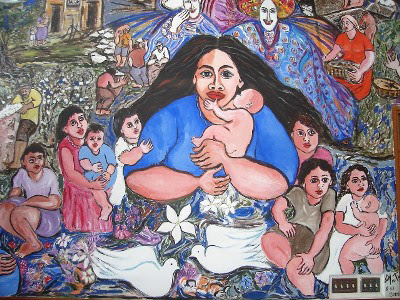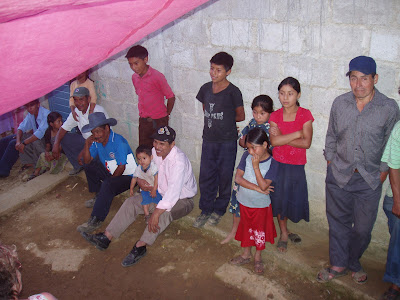Church as it was at time of first visit, 1998--parish postcard picture
Counties in Chiapas that had Catholic chapels & churches attacked, or closed by local authorities in the period before April, 1998.
Miraculously no one was mortally wounded. Many parishioners were imprisoned. Now the violence has subsided. Persistent work for justice, persistent prayer by many, persistent preaching and hearing confessions by Padre Heriberto and the committed clergy of the area—these have made the difference. They believe in the power of confession. The military employed locals to fight as paramilitaries, creating divisions Protestant and Catholic, even dividing Catholics within parishes and families against each other—lured by monthly payments in a land of poverty. To reconcile these wounds the priests ask the perpetrators to come to confess their sin, make some reparation, and come back into community as brothers and sisters. And the people are doing this. Step by step, one by one.
La salud no debe ser un lujo. Health ought not to be a luxury. Poster by Medicos del Mundo
"Chol" means "people of corn" -- deep roots of Mayan culture. Image is framed picture in parish office area.
Challenged as to how fast everyone could make it up some of the steep slopes, most of our group had trouble keeping up with the Jolja children, yet D.J. [perhaps from years scrambling on hockey rinks up north] distinguished himself by keeping up with the young men. For this he was re-christened, Comandante Ti Che [D.J., Chol pronunciation]. The clinic which we thought would only be for part of the afternoon, stretched well into the evening. The people kept coming, so we opened up the door of our improvised care center, which was Rogelio’s parents simple sleeping space/living room, to more patients for half the following day. The family had moved out to stay with others, so we could sleep there, that night in between. With Rogelio his Dad translating, and Andrea who’s a nurse helping at times, we saw some 60 patients. Many had routine complaints that could be addressed by advice, and some basic medicines we distributed. Three children had chronic debilitating illness. We emphasized with the patients’ families the important task of pursuing public health assistance. Their names were referred back to our church clinic in Tila doctor, so hopefully they can make connection with ongoing health care. It is too easy for people to fall between the cracks in these mountainous remote areas.
Waiting outside improvised cinderblock home clinic in Jolja
When we returned to Tila, quickly and gladly we were re-directed to another rural community in the opposite direction down the mountains towards Tabasco, to pray with those who’ve re-opened their church, after years of it having been boarded up by the local government.
The village of Nuevo Limar had been a bad place to be a Catholic. The 16 year old health promoter that I’d worked with ten years ago at the Tila clinic, was a refugee from this community who, at ten, had been beaten mercilessly by his Nuevo Limar public school teacher--for being a Catholic of the San Cristobal diocese. Returning this year with our small group of young people, we visited Jose now 26, and the father of two children, who now operates a medical clinic openly out of his own home. We attended a prayer service presided over by his father, at the Catholic chapel which has re-opened in his village. At the same time Padre BaldemarChol community, said mass in a neighboring town. This is happening in the same Zona Baja region of the diocese, so hostile that paramilitaries there {they go by the misnomer, Paz y Justicia} had ambushed the bishops’ & catechists’ caravan when they attempted to bring the celebration of mass nine years ago.
Jose Inez on left had been my translator 10 yrs ago- now has his own clinic in Nuevo Limar
The transformation has been remarkable. Free to practice their religion publicly in this area, there was participation from all assembled [not as many as usual because some had gone over to the next town for Padre Baldemar’s mass]. Many young people did attend, and the scripture readings, homily discussion, and music were their responsibility, and done well. Bridget worked hard to tune an infrequently played violin, Andrea played guitar, and with an enthusiastic youth choir, they all together made a joyful sound.

eturning again to Tila, we arranged the next day for Cassie, who is a teacher in Chicago’s school system, to visit fifth grade classes in a Tila neighborhood school. Don Ramon was our contact person. I’d known him as one of the few active Catholics who’d been able to persist as a teacher in Tila’s public schools, very prejudiced against San Mateo parish. He was now the principal of this public school – a tribute to his dedication in the cause of faith and education. The children and staff welcomed Cassie, who could take in just a little of their lesson content with her beginning Spanish. But she was impressed with their behavior, and they with her tall basketball & soccer skills. Earlier that morning we’d all helped served these kids at a San Mateo daily breakfast program up a long cliff-side staircase from the grade school.
I learned later from my daughter Bridget, that she’d been offended by the commercialization of the feast day of Corpus Christi in Tila. There were wall-to-wall booths filling all city streets, selling CD’s, candles, an assortment of religious objects to fit all pocketbooks, as well as everything you’d find at a county fair market day, engulfing the whole town and overwhelming the parish at its center. There was even an electric light trimmed Ferris wheel jammed into the municipal plaza across the street from the church.
The pastor Padre Heriberto was more directly affronted, I told her. At a major afternoon mass he preached against those in the town who, most of the year, called the Sanctuary Nuestro Senor de Tila, and the faith of its people, a sham, a fairy tale. Now those same local critics had become merchants-- selling religious articles, food and lodging to the pilgrims—and praising the miraculous blessings to be received. The words of his homily challenged the hypocrisy--boomed out from the church loudspeakers, through the stalls in the streets into market, restaurant, and rooming house for all ears to hear. It was a moment that profiled pastoral prophetic courage, especially with the history of town government hostility towards the parish community. I wished that our young adult companions had been able to appreciate the Spanish clarity of the message. In translation, I informed them that concern for a simple true faith, not to be cashed in on, was the unmistakable message from the pulpit.
Then, after a week in Tila, we were sailing down the mountain roads again, four hours starting in the dark mists of pre-dawn, under the guidance of the fast stop & go parish chauffeur towards Villahermosa, Tabasco and our airplane home. This time I rode in the back bed of the large pickup, open to the “cloudforest” elements. [Parts of this tropical/temperate high altitude area are an international nature reserve.] On the way up late at night, D.J. had been the open-air rider of these speedy switchback roads. One had to keep well down on the foam mats provided, to stay stable and to ward off chill from the high altitude breeze, a little cold even in this state at the southernmost border of Mexico, in June.
Two flights later, having regained U.S. soil at the airport hub in Atlanta, where we were subjected to an astonishing run-with-your-bags helter skelter customs process, we rested in a not-so-fast food restaurant, and briefly reviewed our time in Tila. Bridget, Cassie and D.J. concluded they’d been overwhelmed by crowds & language, sometimes bored, at times over-regulated by yours truly, and wished they’d been capable of acting on their own more independently. Yet they were glad to have taken this first step, gone to meet these people in this far away land, especially those befriended in the community of Jolja, and learned something of their way of life. Andrea and I were gratified we’d been able to help this happen, and hope that more connections like this, between first and third world young adults, can be arranged in the future--to nurture a faith that transcends borders, and trust in God who calls us all to be peacemakers. At the recommendation of Padre Heriberto, and by our own good intuition, this won’t again be during the busy days of Corpus Christi celebrations.


Prayer to Our Lord of Tila
In this blessed image, made new 300 years ago, you have shown to all those who come confidently to You, the merciful love of God the Father.
We give You thanks, and through You we give glory to the Heavenly Father, for all wondrous deeds realized and benefits received.
You who said, “Come to me all you who are tired and overburdened, and I will give you rest,” look upon us with kindness. As you already know our sufferings, and have invited us to ask confidently in your name for what we need, I ask you to hear me and grant my supplication…..{here add your petition}.
As you allow me only what is for my good, enlighten me to discover and know the benefits that your love has conferred on me, to understand sharing the anguish and sufferings of my brothers, and sisters, and all who work for your kingdom, struggling for truth, justice, and peace.
By Padre Heriberto Cruz Vera
Illumination by Kathy Brahney






















 The failsafes designed for General Electric’s Fukushima reactors failed. This was anticipated by some; at least four GE engineers had quit over their reactor vessel safety concerns [see references below]. GE did some retrofitting—but still lost tragically in its bid to “bring good things to light.” There are 23 nuclear power plants with these defects now operating in the United States. 2
The failsafes designed for General Electric’s Fukushima reactors failed. This was anticipated by some; at least four GE engineers had quit over their reactor vessel safety concerns [see references below]. GE did some retrofitting—but still lost tragically in its bid to “bring good things to light.” There are 23 nuclear power plants with these defects now operating in the United States. 2 3-17-2011—Kagoshima Wind Farm in Japan—photo by Rjzii
3-17-2011—Kagoshima Wind Farm in Japan—photo by Rjzii
